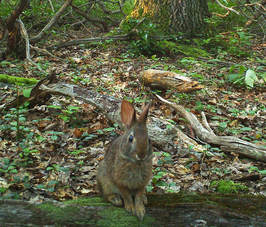 A New England cottontail ventures into the open.
A New England cottontail ventures into the open. A new study led by Dr. Amanda Cheeseman and recently published in Ecology and Evolution confirmed that there is cause for concern about competition between the two cottontail species. Her results demonstrated that where eastern cottontails were prevalent, New England cottontails tended to choose sites with traits representative of mid- to late stages of forest succession such as dense tree canopy cover, tall shrubs, and moderate densities of Japanese barberry, an invasive understory shrub that thrives in low sunlight conditions. Where eastern cottontails were not prevalent, New England cottontails tended to choose sites with low to moderate tree canopy cover and areas of higher grass and herbaceous cover, characteristics common of earlier stages of forest succession.
The displacement of New England cottontails into later successional forest by eastern cottontails could impact the survival and population trends of the native rabbit, a subject of ongoing study by the Cohen lab. The findings also have important implications for habitat restoration to benefit the New England cottontail, which until now has focused strongly on completely removing tree canopy cover to allow growth of shrubs and herbaceous vegetation. With eastern cottontails common throughout most of the range of New England cottontails, such an approach could encourage the competing eastern cottontail, which thrives in open areas, while having minimal benefit to New England cottontail. Experimental management that preserves different levels of tree canopy and understory shrub cover in areas that vary in eastern cottontail prevalence is underway in New York. We hope that with new information, we can help managers to reverse the decline of this unique part of our natural heritage.
 RSS Feed
RSS Feed
